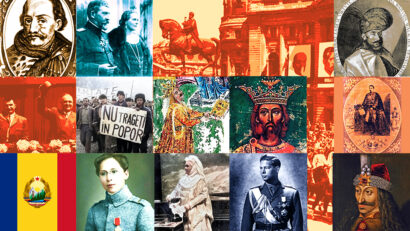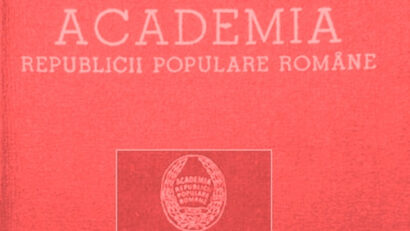The early days of Romanian national independence movement
Revolution and betrayal in the Romanian Principalities in the 19th century

Steliu Lambru, 24.05.2021, 02:00
A movement with predominantly political aims took
shape in Wallachian principality’s western part, Oltenia, in January 1821. The
head of the movement was Tudor Vladimirescu. He was a former military in the
Russian army who had become a merchant. In his undertaking, Vladimirescu was
influenced by the Enlightenment nationalist ideas of his time.
Tudor Vladimirescu led a 5,000-strong group or armed
men and reached Bucharest in March. There he tried to render the ideas of his
time more coherent. For nearly two months running, Vladimirescu ruled
Wallachia. However, in May 1821, he fled Wallachia, because of a prospective
Turkish invasion. On May 21, 1821, Tudor Vladimirescu was assassinated by the
Greek nationalists, who accused him of treason. That movement, which took shape
200 ago, has for long been described as the beginning of the Romanian national
emancipation process.
However, the geo-political situation in the Balkans was
a little bit more complicated. Greek nationalism, in hot pursuit for the
independence of Greece, fuelled the revolutionary society Eteria (the
Brotherhood). Russia offered a strong support to the Greek nationalism, which
also enjoyed the support coming from the Romanian Principalitiesthrough their
Phanariot ruling princes. We recall the Phanariotes were of Greek origin. They
hailed from Constantinople’s FAnar district and had been appointed by the
Ottoman Porte at the helm of Wallachia and Moldavia beginning 1716. Small
wonder then that the 18th century in its entirety has been dubbed the Phanariote
century. It was perceived in a negative way, by contemporaries as well as by
posterity.
The allegedly common Romanian-Greek project, in 1821
would turn into two separate projects, the Greek project and the Romanian
project. Each or of the two projects were to be carried through in different
ways.
Historian Alin Ciupala accompanied us in our bid to
retrace the history of the movement headed by Tudor Vladimirescu 200 years ago.
Our attempt was to view the events of the past in a contemporary perspective. Alin
Ciupala was keen on emphasizing the essential contribution of the patriot
boyars to the launching of the insurrection.
Alin Ciupala:
There is an element which was
generally ignored and which was deliberately omitted by the communist regime,
namely the role the national high-ranking class of boyars played in that. This
class was under the influence of the Enlightenment ideas originating in the
West and reaching the Balkans through the Greek culture. In effect, these ideas,
which part of the Romanian high-ranking boyars embraced, caused the breakup we
noticed especially in the second half of the 18th century’s later
part. Actually, there is the breakup between the Greek national project and
what was about to become the Romanian national project. In other words, the
Greek nationalism which the Phanariot ruling princes and Greek boyars
patronized in the Principalities went at loggerheads with the nationalism of a
sizeable part of Romanian high-ranking class of boyars. Which prompted the
Romanian class of boyars to find solutions to remove the Phanariotes from
power.
The Greeks stood to gain from this movement, the
Romanians stood to gain from that as well, but in a different way. The Greeks
were in control of the political, administrative and military means in
Wallachia, while the Romanians were in control of the economic ones. According
to Alin Ciupală, Tudor Vladimirescu was the solution found by the Romanian
class of boyars, a solution that was not envisaged by them, notwithstanding.
Alin Ciupala:
It is against such a backdrop that Tudor
Vladimirescu made his presence felt. He was a man of action, a man with a
military experience, he fought in the Russian-Ottoman war of 1806-1812, he was
even granted medals by the Russian military authorities. He was hired by the
patriot boyars, he was called to Bucharest, he was entrusted with certain sums
of money, and his mission was to go to Oltenia to organize, arm and lead the
pandurs, a light infantry corps he belonged to, all the way back to Bucharest. It’s
just that Vladimirescu would take the whole undertaking on his own once he got
to Oltenia, since he saw himself with so much authority on his hands and with
so many people looking up to him, so he managed to muster a 5,000-strong army
corps or thereabouts. He would depart himself from the high-ranking boyars’
project and head for Bucharest with the ever clearer intention of filling the
power vacuum that occurred in the wake of the death of Wallachia’s last
Phanariot ruling prince.
But what, in terms of interest, united
the high-ranking boyars and Tudor Vladimirescu ?
Alin Ciupala:
The
high-ranking boyars and Tudor Vladimirescu did have a point in common, namely
casting the Phanariotes out. The collaboration relationship saw its breakpoint
the moment Tudor Vladimirescu took the action on his own, completely. When that
happened, the high-ranking Romanian boyars would flee to Brasov and Sibiu,
where they found protection, while Vladimirescu found himself all alone, trying
to impose his own authority. We have lots of documents revealing his constant
effort to obtain the support of the boyars who remained in the country, since
the boyars were the only ones to give him the legitimacy he needed to hold a
position of authority.
T
he Greek national movement awaited Russia’s great support.
Such a support was never offered by Russia and Vladimirescu’s pandurs army
corps splintered from the Greek army. The situation became unclear and the
Ottoman troops set things to rights. Was the
whole undertaking a failure?
Alin Ciupala:
These events and the Greek revolution
overlapped, and the moment the Ottoman Empire was assured, via diplomatic
channels, that Russia would not interfere for the support of the Greek
revolution, the Ottoman military intervention was launched. Interesting to note
that clashes between the Ottoman troops and Tudor Vladmidrescu’s pandurs army
corps never happened, which is a clear sign of the fact that the aim of the
Ottoman intervention was to quash the Greek revolution.
Tudor Vladimirescu’s tragic end and the events rushing
forward had nonetheless a positive effect on posterity. The Romanian elites
would return on the throne of the Romanian Principalities, while the national
strategy they thought out for the future would be more articulate.




























